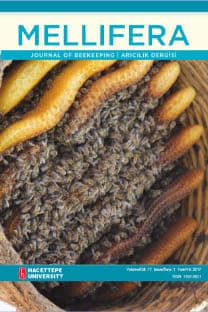İzleme ve refakat-dans bilgisi edinme durumundaki bal arılarının iki ayrı davranış kalıbı
Bu çalışma, dansta dokunmalı iletişime ilişkin kuram üzerinde daha ileri düzeyde durmaktadır. Burada, dans edimi içindeki annın çevresinde bu arıya sallanarak eşlik eden diğer anların davranıştan videoya alınmıştır. Daha sonraki kayıtlar, yavaşlatılmış çekimlerde kare kare analiz edilmiştir. Video analizleri, kimi arıların dans eden yanında çeşitli davranışlar sergilediklerini, diğerlerinin ise dans edenle özel olarak etkileşim içine girdiklerini göstermektedir. Bu süreçteki 11 farklı olay arasında cereyan eden davranışsal değişimler kayda alınmış ve analiz edilmiştir. Ardından, gözlenen davranışsal olayları içeren olası 55 kombinasyondan 34'ü için Pearson korelasyon katsayıları hesaplanmıştır. Bulunan korelasyon katsayılarını temel alan faktör analizi, hiyerarşik olarak şu şekilde sıralanabilecek 4 ana faktör ortaya koymuştur: (1) devriye -> (2) refakat => (3) dışardan izleme => (4) içerden izleme. Dans eden anyla sallanma ve dönüş uçuşu dahil olmak üzere tüm dans boyunca yakın temas kurabilen anlar, yalnızca içerden ve dışardan izleme durumunda olan anlardır. Dans eden annın çevresinde bulunan toplam 81 an arasında 44'ü içerden, 17'si ise dışardan izleyici durumundaydı. Bu çalışma dokunmaya dayalı iletişimle ilgili giderek artan literatüre bir katkı niteliğindedir ve ayrıca izleyici anlann refakatçi anlardan ayırt edilmesi gerektiğini savunan daha önceki çalışmalanmızı destekleyici içeriktedir.
Following and attending-two distinct behavior patterns of honeybees in a position to collect the dance information
The paper further explores the tactile theory of dance communication. Waggle dances and the behavior patterns of bees near the dancer were videotaped. The subsequent recordings were analyzed during slow motion playback and frame by frame. Video analysis showed that some bees performed various behaviors near the dancer and other bees specifically interacted with the dancer. Behavior transitions between 11 different events were recorded and analyzed. Pearson correlation coefficients were calculated for 34 pairs of observed behavioral events out of 55 possible combinations. Factor analysis based on correlation coefficients revealed 4 major factors, which can be ranked in hierarchical order: (1) patrolling => (2) attending => (3) outer following => (4) inner following. Only bees that performed inner or outer following were able to maintain close contact with the dancer during the entire dance cycle including waggle and return run. Out of 81 bees in the dancers' vicinity, 44 were inner and 17 were outer followers. This paper contributes to the growing literature on the reevaluation of tactile communication, and further supports our previous work that follower bees must be distinguished from attending bees.
___
- 1. Von Frisch, K., Tanzsprache und Orientirung der Bienen, 1 ed., Springer Verlag, Berlin - Heidelberg, 1965.
- 2. Esch, H., Über die Schallerzeugung beim Werbetanz der Honigbiene, Zeitschrift fuer vergleichende Physiologie, 45, 1-11, 1961.
- 3. Towne, W.F., Acoustic and visual cues in the dances of four honey bee species, Behavioral Ecology and Sociobiology, 16, 185-187, 1985.
- 4. Michelsen, A., Kirchner, W.H., Lindauer, M., Sound and vibrational signals in the dance language of the honeybee, Apis melli-fera., Behavioral Ecology and Sociobiology, 18,207-212,1986.
- 5. Michelsen, A., Towne, W.F., Kirchner, W.H., Kryger, P., The acoustic near field of a dancing honeybee, Journal of Comparative Physiology A, 161, 633-643, 1987.
- 6. Kirchner, W.H., Lindauer, M., Michelsen, A., Honeybee dance communication - Acoustic indication of direction in round dances, Naturwissenschaften, 75, 629-630, 1988.
- 7. Kirchner, W.H., Dreller, C, Towne, W.F., Hearing in honeybees: Operant conditioning and spontaneous reactions to airborne sound, Journal of Comparative Physiology A, 168, 85-90, 1991.
- 8. Dreller, C, Kirchner, W.H., Hearing in honeybees: Localization of the auditory sense organ, Journal of Comparative Physiology A: Sensory, Neural and Behavioral Physiology, 173, 275-279, 1993a.
- 9. Kirchner, W.H., Acoustical communication in honeybees, Apidologie, 24, 297-307,1993.
- 10. Kirchner, W.H., Hearing in honeybees: The mechanical response of the bee's antenna to near field sound, Journal of Comparati-and Physiology, A Sensory Neural and Behavioral Physiology, 175, 261-265., 1994.
- 11. Von Frisch, K., Über die "Sprache" der Bienen, eine tierpsychologische Untersuchung, Zool.Jb.Physiol 40, 1-186, 1923.
- 12. Wells, P.H., Wenner, A.M., Do honey bees have a language, Nature 241, 171-175,1973.
- 13. Wenner, A.M., Wells, P.H., Anatomy of a controvery: the question of a/language® among bees, Columbia University Press, • New York, Oxford, 1990.
- 14. Von Frisch, K., Die "Sprache" der Bienen und ihre Nutzanwendung in der Landwirtschaft, Experientia, (2) 10, 397-404, 1946.
- 15. Bozic, J., Valentincic, T., Attendants and followers of honeybee waggle dances, Journal of Apicultural Research, 30,125-131, 1991.
- 16. Judd, T.N., The waggle dance of the honey bee: Which bees following a dancer successfully acquire the information?, Journal of Insect Behavior, 8, 343-354, 1995.
- 17. SAS Institute Inc., SAS/STAT User's Guide, Release 6.03 Edition, Cary, NC: SAS Institute Inc., 1988.
- 18. Esch, H., Bastian, J.A., How do newly recruited honey bees approach a food site? Zeitschrift fuer vergleichende Physiologie, 68, 175-181., 1970.
- 19. Bozic, J., Social interactions of honeybees in hive, Master of Science Thesis, University of Ljubljana; Ljubljana, 1992.
- 20. Bozic, J., Abramson C.I., Multiple search flights of the dancer's followers: Result of information or energy deficieny, In: Proceedings of the XXXVII congress, Apimondia, Ljubljana, 2003.
- 21. Seeley, T.D., Devision of labor between scouts and recruits in honeybee foraging, Behavioral Ecology and Socbiology 12, 253-259,1983.
- 22. Rohrseitz, K., Tautz, J., Honeybee dance communication: Waggle run direction coded in antennal contacts?, Journal of Comparative Physiology A, 184, 463-470, 1999.
- 23. Martin, H., Lindauer, M., Sinnesphysiologische Leistungen beim Wabenbau der Homgbiene, Zeitschrift fuer vergleichende Physiologie, 53, 372-404, 1966.
- 24. Dreller, C, Kirchner, W.H., How honeybees perceive the information of the dance language, Naturwissenschaften, 80, 319-321,1993c.
- 25. Dreller, C, Kirchner, W.H., Hearing in honeybees: Localization of the auditory sense organ, Journal of Comparative Physiology A Sensory Neural and Behavioral Physiology, 173, 275-279, 1993b.
- ISSN: 1302-5821
- Başlangıç: 2001
- Yayıncı: Hacettepe Üniversitesi
